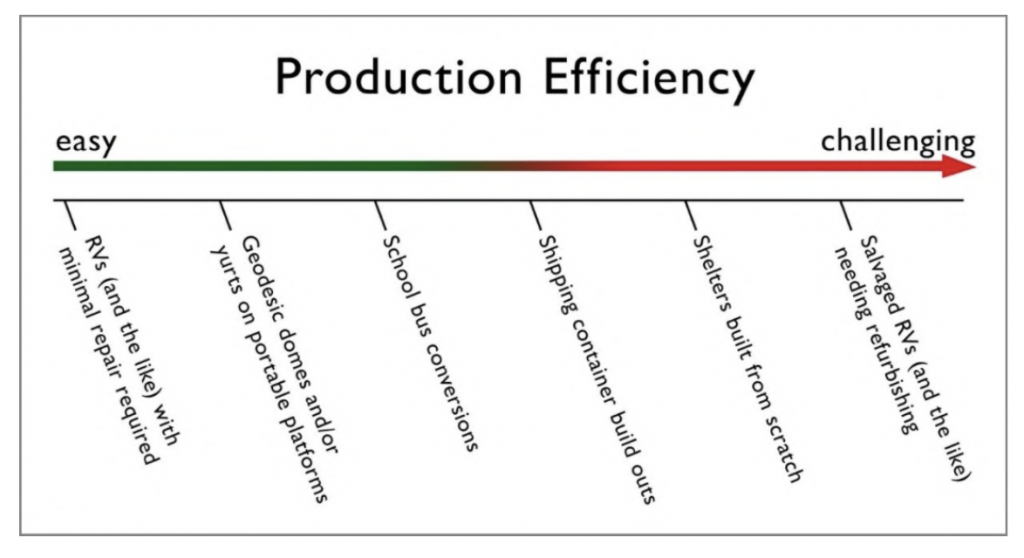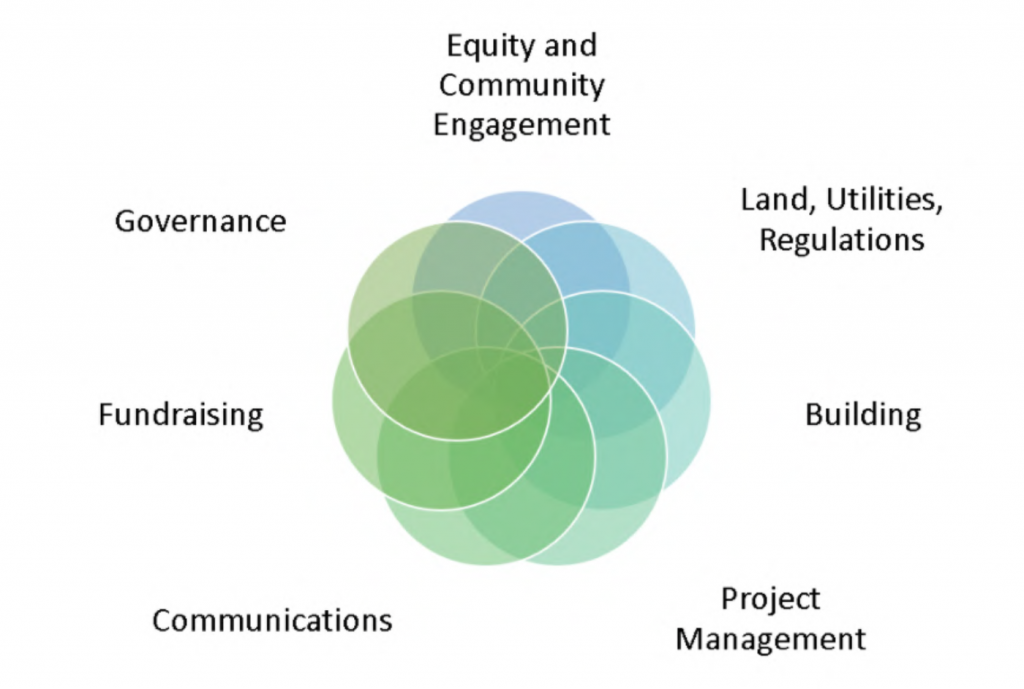My Valley My Home/Mi Valle Mi Hogar
Rebuilding after the Almeda Fire
Rogue Valley Homes and Shelter Relief (RVHSR) initiative
Executive Summary
Our goal
Support the populations most devastated by the destruction of homes during the Almeda Fire, especially those for whom racial and socio-economic inequities were pre-existing – such as migrant, worker, indigenous and unhoused community members.
Specifically:
- Provide assistance with immediate and short-term temporary shelter and local housing, particularly to prevent permanent departure from our community.
- Create sustainable long-term housing that includes a pathway for residents to own equity in the housing unit and/or land.
- Core values and guiding principles
- Collaboration, inclusivity, cultural sensitivity
- BIPOC leadership and social equity
- Community ownership, stability and mutual self-help
- Long-term and resilience thinking
- Sustainability, safety, quality and appropriate technology
Partnerships and resources
In a matter of days, this project has developed into a cross-sector, community-driven initiative with financial, volunteer and other support. Our collaborators include:
- Grassroots and established nonprofit community-based organizations
- Local businesses and landowners
- Skilled tradespeople providing pro-bono labor
- Local, regional and state government representatives
- Disaster management specialists
- Sustainability experts
- Legal advisors (nonprofit, land use and migrant attorneys)
- Foundations and other philanthropic entities
Demonstration of a promising practice
This project could become a model for other communities who, after a disaster, wish to take a more innovative approach to rebuilding with social equity, sustainability, and long-term resilience at the core.
Project scope and cost
The preliminary estimate for this project, including residents’ equity ownership of land and/or home unit, is approximately $100,000 per family unit, with a goal to support up to 500 families.
Get involved
To discuss funding, land or material donations, or other opportunities to collaborate, please email info@roguevalleyhsr.org. To get involved in this project, please fill out this short survey. https://tinyurl.com/yxtuedku
Project Overview

Vision
In the face of crisis in the Rogue Valley, the community is mobilizing to help provide shelter in the near-term and rebuild permanent housing in the long-term for marginalized families who were rendered homeless by the Almeda fire. In a collaborative, inclusive and culturally-sensitive effort, building on our existing local capacity, skill and knowledge-base, we envision the regeneration of our displaced community with dwellings that are equity-centered, safe, sustainably built and family- and community-owned. We intend that what grows back from the ashes is more resilient and sustainable than what stood before, and that the process itself reweaves our community into a fabric of greater stability and wholeness.

Inspiration Born from Tragedy
On September 8, 2020, the Almeda fire swept through Ashland, Talent, Phoenix and South Medford, destroying 2,357 homes, damaging 57 more, and displacing approximately 40,000 people. This tragedy has disproportionately affected seasonal workers and BIPOC communities; an estimated 500 low-income families who are without insurance, basic resources, or any backup plan, are also now without housing.
Just a few days after the fire, a small group of community members – led by Donnie Maclurcan and Lebeau Potgieter, along with John Palombo and Atlas Newman (who had assembled 100+ builders through the grassroots Rogue Volunteer Initiative) – came together to harness their inspiration to help the most vulnerable members of our community who had been impacted by the fire, forming the My Valley My Home/Mi Valle Mi Hogar project.
The project leaders were concerned that those affected by the Almeda fire might be forced to leave the Rogue Valley – being keenly aware of the tragedy in communities such as Paradise, CA, where displaced residents were forced to shelter far from home and never returned. The group quickly convened and expanded to incorporate indigenous leadership and other immediate diverse stakeholders, including community members, government officials, business owners, funders, and community-based organizations. Together, these groups began by mapping resources, identifying missing stakeholders, and establishing a plan to provide short-term housing followed by long-term, sustainable, safe, energy efficient, equitable family– and community–owned housing and land for those that have been hit the hardest. The project has a particular focus on those for whom racial and socio-economic inequities were pre-existing, such as migrant, undocumented, indigenous and unhoused community members, with additional consideration for the elderly, multi-generational families and, people with disability.

Activity in Progress
Approaches to responding to this unprecedented crisis are emerging organically as stakeholders come together to unite their skills, knowledge and wisdom – including designers, planners, property owners, builders, workers, project managers, and financial donors (please refer to the Appendix for an evolving list of project partners and committed resources).
This collective is working together – through an equity lens – with local non-profit organizations and municipalities to address the housing need by exploring a range of options, such as: refurbishing RVs and buses; undertaking shipping container fit outs; and building tiny houses. As outlined in the image below, options will need to factor in the difficulty and timeframes associated with each.
Other key activities already in progress include:
- Establishment of a working group
- Establishing the project fund under the gracious fiscal sponsorship of the MRG Foundation
- Outreach to impacted families, including establishment listening circles for all members of the project to hear the stories of those most impacted
- Establishing surveys for contributions of land/vehicles, and developing a means of suitability assessment
- Securing resources, including approximately 60 acres of land, a corps of skilled builders and equipment, and pledges of funding
Proposal for the Rebuild
While the rebuild proposal is currently under development, we broadly envision three overlapping phases:
Phase 1
The initial phase to help identify immediate shelter for families is already underway and will continue for the coming weeks. Outreach is happening to impacted communities to better understand their situation and needs.
Phase 1 involves RVs that are move-in ready. With the risk of the community dispersing rapidly, we hope to provide immediate land and RV hookups to ensure our community in need has a roof over their heads in the near term. (within the first month).
Surveys are being established to map the RV and land inventory. We are working with city leaders to find land that can have zoning restrictions removed in order to position these RVs on land immediately.
Phases 2 and 3
The Rogue Volunteer Initiative has amassed nearly 200 volunteers skilled in various trades – general contractors, carpenters, electricians, plumbers, heavy machinery operators, arborists, and laborers. From this group, a team of project leads has been distilled, capable of leading a crew and taking responsibility for all stages of construction. The intention is to organize construction projects in collaboration with their network of associated organizations, to staff initial training with project leaders, and then assign pods of skilled volunteers to each lead that can then efficiently reproduce shelter designs.
An initial bus refurbishment project is underway to train the project leads, building on Julie Akin’s previous work with Vehicles for Changes. The aim for Phase 2 is to have community owned, temporary housing (containers, buses, RVs) positioned in micro-pods/communities around our valley during months 2-18. These units will be easy to move and relocate back to Talent and Phoenix as soon as clean-up is complete. Phase 3 will be centered around land ownership and permanent housing for the community impacted by the fires. Phase 3 has a 12month+ time horizon.
A comprehensive budget will be developed for phases 2 and 3.
Mobilizing Resources and Next Steps
Additional resources being pursued include:
- Funding (donations and financing)
- Additional land
- RVs, trailers and other short-term shelter
- Building materials, including yurts, buses, and shipping containers
- Subject matter experts, offering services pro-bono
Some next steps include:
- Establishing the listening circles
- Drawing on partners to formalize representation from the teams into a larger working group
- Outlining and assigning key roles to willing volunteers
- Surveying potential land
- Surveying potential RV’s, trailers, tiny homes
- Refining project goals and plan according to input from impacted families
Organizational Structure and Approach
In its early stages, this project will be managed across several distinct and coordinated teams.
by Gretchen Fox
Communications Lead
Rogue Valley Homes and Shelter Relief initiative


Advertisement